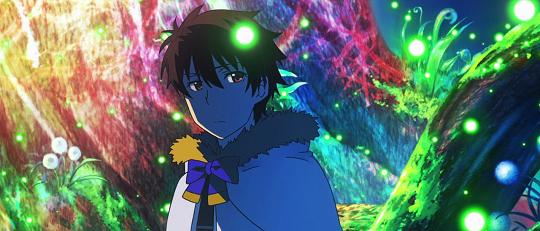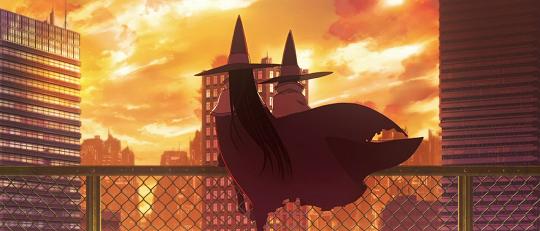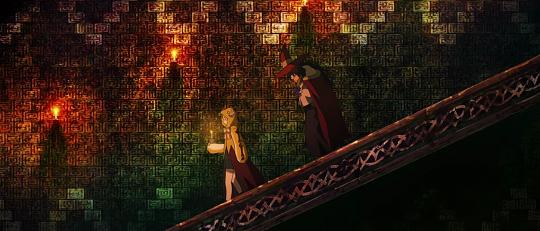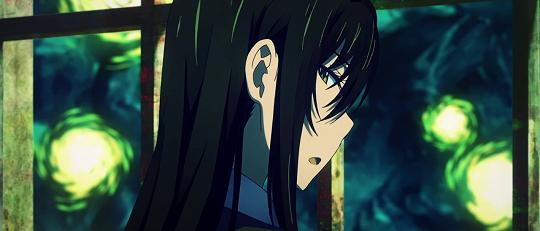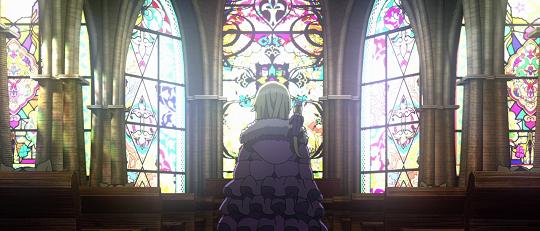Either I was subject to a maliciously obtuse translation or my mind must have been elsewhere during all of the important explanations in Witch Craft Works because not much really makes sense. Like repeatedly walking in during the middle of a spy thriller, vast swathes of WCW’s world and rules are left unexplained until long after when it was needed. It wouldn’t have improved the story or made the main characters any less wooden, but it would have at least let the plot flow a little more naturally.
From what I can gather, Honoka Takamiya is a thoroughly boring young man; lacking friends and any noteworthy hobbies and for all intents and purposes didn’t exist until the tall, stoic and busty Ayaka Kagari crashes into his life on a broomstick and wearing a witch’s hat. Due to ill explained purposes, Tower witches are attacking Honoka and it’s up to her and more or less every other Workshop witch in a five mile radius to protect him. Oh and civilians can’t be hurt by witches because of Reasons™ and any property damage caused by witch-on-witch scuffles magically repairs itself.
Except when it suits the plot not to and instead incapacitate the witch who facilitates the mystical reconstruction. The minutiae of the rules governing this matriarchal world of witch covens and ancient pacts with cities is begrudgingly exposed and perhaps better explained in the source material manga, however it’s indicative of the woefully uncoordinated plot as a whole. Antagonists (including the delightfully named Tanpopo) are introduced and discarded with gay abandon yet most have an alarming tendency of surrendering their Tower coven allegiance and go and live with Honoka in his three bedroom suburban home. This includes the gorgon Medusa whose persistently confusing design includes a straight jacket, cat-eared familiars and a giant snake.
When the final antagonist of the series, Weekend, does make her move she is summarily thrashed by several tertiary characters before even facing a somewhat more determined Ayaka (you can tell by the scowl). There’s just no clear and present danger to any of the showdowns; even when casualties happen they are magically healed, sometimes minutes later by the very person who wielded the knife. It makes the supposed climactic battle just as toothless as any other encounter, even when set in a church with full height technicolour stained-glass windows. This is without a doubt a very pretty production with solid animation throughout, especially given the inventive and detailed character designs. It’s definitely not every series you see a witch toting a giant grimoire with two hands sticking out the top attacking alongside her comrades, super sentai-esque.
It’s easy to forget how the series started though with a CG army of steampunk rabbits bum rushing Honoka and Ayaka in the school quadrangle, followed shortly after by a Godzilla sized teddy bear destroying whatever bland city the series is set in. For a few episodes at least it appears to be establishing itself with a nuts-and-bolts monster of the week format supported by a thoroughly tedious “school princess” figure befriending an earnest but otherwise dull as mud male. Almost every episode he awakens having been saved by the fiery Ayaka yet again after he was, surprise!, attacked by a new pack of witches. There is the promise of a quirky role reversal with the majestic Ayaka playing the knight to Honoka’s damsel in distress but the series just isn’t smart enough to play it out: Honoka eventually turns out to be ridiculously overpowered and the source of Ayaka’s limitless magic to boot. What gender role reversal there is can be distilled down to Ayaka playing the creepy stalker - going so far as tirelessly watching him sleep - taking the place of the usual male lead.
Yes, this is fundamentally the story about a banal teenage boy having his life turned upside-down when he finds out he has a cabal of ladies fawning over him and generally waiting on him hand and foot. Anything that doesn’t serve the purpose of smooshing Honoka and Ayaka together - whether that’s her cleaning his ears or her incongruously dressing up in a cleavage-showing nurses outfit - is often unceremoniously ignored. Honoka is after all one of only two males in the WCW universe, three if you count the bipedal crocodile butler, a situation best summed up by Ayaka when she off-handedly mentions males aren’t well thought of in witch circles.
It would be tempting to say that Witch Craft Works’ good and bad points even out to “enjoyable”, but in reality you have a colourful and solid aesthetic covering a patchy story that itself covers stagnant mediocrity. It’s left to the secondary characters - Medusa, Tanpopo and her cronies or Honoka’s younger sister Kasumi - to cover for Ayaka’s painfully aloof delivery and Honoka’s general dunderheadedness. A lot of flash, a modicum of promise and a whole lot of crazy (I’m looking at you Witch Activity ending) don’t hide a rote, by-the-numbers harem-lite setup and broadly unengaging execution.





